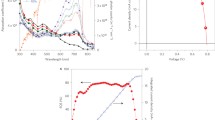Abstract
The efficiency of conversion of light to electrical energy with the help of conjugated polymers and molecules is rapidly improving. The optical absorption properties of these materials can be designed, and implemented via molecular engineering. Full coverage of the solar spectrum is thus feasible. Narrow absorption spectra allow construction of tandem solar cells. The poor transport properties of these materials require thin devices, which limits optical absorption. Alternative device geometries for these flexible materials compensate for the optical absorption by light trapping, and allow tandem cells.


Similar content being viewed by others
References
Blankenship, R.E., D.M. Tiede, J. Barber, G.W. Brudvig, G. Fleming, M. Ghirardi, M.R. Gunner, W. Junge, et al. 2011. Comparing photosynthetic and photovoltaic efficiencies and recognizing the potential for improvement. Science 332: 805–809.
Clarke, T.M., and J.R. Durrant. 2010. Charge photogeneration in organic solar cells. Chemical Reviews 110: 6736–6767.
Deibel, C., and V. Dyakonov. 2010. Polymer-fullerene bulk heterojunction solar cells. Reports on Progress in Physics 73: 096401.
Deibel, C., V. Dyakonov, and C.J. Brabec. 2010. Organic bulk-heterojunction solar cells. IEEE Journal of Selected Topics in Quantum Electronics 16: 1517–1527.
Dennler, G., M.C. Scharber, and C.J. Brabec. 2009. Polymer-fullerene bulk-heterojunction solar cells. Advanced Materials 21: 1323–1338.
Gadisa, A., M. Svensson, M.R. Andersson, and O. Inganäs. 2004. Correlation between oxidation potential and open-circuit voltage of composite solar cells based on blends of polythiophenes/fullerene derivative. Applied Physics Letters 84: 1609–1611.
Green, M.A., K. Emery, Y. Hishikawa, and W. Warta. 2011. Solar cell efficiency tables (version 37). Progress in Photovoltaics 19: 84–92.
Halls, J.J.M., C.A. Walsh, N.C. Greenham, E.A. Marseglia, R.H. Friend, S.C. Moratti, and A.B. Holmes. 1995. Efficient photodiodes from interpenetrating polymer networks. Nature 376: 498–500.
Inganäs, O. 2011. Organic photovoltaics: avoiding indium. Nature Photonics 5: 201–202.
Inganäs, O., F.L. Zhang, and M.R. Andersson. 2009. Alternating polyfluorenes collect solar light in polymer photovoltaics. Accounts of Chemical Research 42: 1731–1739.
Inganäs, O., F.L. Zhang, K. Tvingstedt, L.M. Andersson, S. Hellström, M.R., and Andersson. 2010. Polymer photovoltaics with alternating copolymer/fullerene blends and novel device architectures. Advanced Materials 22: E100–E116.
Pettersson, L.A.A., L.S. Roman, and O. Inganäs. 1999. Modeling photocurrent action spectra of photovoltaic devices based on organic thin films. Journal of Applied Physics 86: 487–496.
Ruani, G., C. Fontanini, M. Murgia, and C. Taliani. 2002. Weak intrinsic charge transfer complexes: A new route for developing wide spectrum organic photovoltaic cells. Journal of Chemical Physics 116: 1713–1719.
Service, R.F. 2011. Outlook brightens for plastic solar cells. Science 332: 293–293.
Svensson, M., F.L. Zhang, S.C. Veenstra, W.J.H. Verhees, J.C. Hummelen, J.M. Kroon, O. Inganäs, and M.R. Andersson. 2003. High-performance polymer solar cells of an alternating polyfluorene copolymer and a fullerene derivative. Advanced Materials 15: 988–991.
Tang, C.W. 1986. 2-Layer organic photovoltaic cell. Applied Physics Letters 48: 183–185.
Tvingstedt, K., V. Andersson, F. Zhang, and O. Inganäs. 2007a. Folded reflective tandem polymer solar cell doubles efficiency. Applied Physics Letters 91: 123514.
Tvingstedt, K., N.K. Persson, O. Inganäs, A. Rahachou, and I.V. Zozoulenko. 2007b. Surface plasmon increase absorption in polymer photovoltaic cells. Applied Physics Letters 91: 113514.
Tvingstedt, K., S. Dal Zilio, O. Inganäs, and M. Tormen. 2008. Trapping light with micro lenses in thin film organic photovoltaic cells. Optics Express 16: 21608–21615.
Tvingstedt, K., K. Vandewal, A. Gadisa, F.L. Zhang, J. Manca, and O. Inganäs. 2009. Electroluminescence from charge transfer states in polymer solar cells. Journal of the American Chemical Society 131: 11819–11824.
Tvingstedt, K., K. Vandewal, F.L. Zhang, and O. Inganäs. 2010. On the dissociation efficiency of charge transfer excitons and Frenkel excitons in organic solar cells: A luminescence quenching study. Journal of Physical Chemistry C 114: 21824–21832.
Vandewal, K., K. Tvingstedt, A. Gadisa, O. Inganäs, and J.V. Manca. 2009. On the origin of the open-circuit voltage of polymer-fullerene solar cells. Nature Materials 8: 904–909.
Vandewal, K., K. Tvingstedt, A. Gadisa, O. Inganäs, and J.V. Manca. 2010a. Relating the open-circuit voltage to interface molecular properties of donor:acceptor bulk heterojunction solar cells. Physical Review B 81: 125204.
Vandewal, K., K. Tvingstedt, J.V. Manca, and O. Inganäs. 2010b. Charge-transfer states and upper limit of the open-circuit voltage in polymer: Fullerene organic solar cells. IEEE Journal of Selected Topics in Quantum Electronics 16: 1676–1684.
Wang, E.G., L.T. Hou, Z.Q. Wang, S. Hellström, F.L. Zhang, O. Inganäs, and M.R. Andersson. 2010a. An easily synthesized blue polymer for high-performance polymer solar cells. Advanced Materials 22: 5240–5244.
Wang, E.G., L.T. Hou, Z.Q. Wang, S. Hellström, W. Mammo, F.L. Zhang, O. Inganäs, and M.R. Andersson. 2010b. Small band gap polymers synthesized via a modified nitration of 4,7-dibromo-2,1,3-benzothiadiazole. Organic Letters 12: 4470–4473.
Wang, E.G., Z.F. Ma, Z. Zhang, K. Vandewal, P. Henriksson, O. Inganas, F.L. Zhang, and M.R. Andersson. 2011. An easily accessible isoindigo-based polymer for high-performance polymer solar cells. Journal of the American Chemical Society 133: 14244–14247.
Yu, G., J. Gao, J.C. Hummelen, F. Wudl, and A.J. Heeger. 1995. Polymer photovoltaic cells-enhanced efficiencies via a network of internal donor–acceptor heterojunctions. Science 270: 1789–1791.
Zhou, Y., K. Tvingstedt, F.L. Zhang, C.X. Du, W.X. Ni, M.R. Andersson, and O. Inganäs. 2009. Observation of a charge transfer state in low-bandgap polymer/fullerene blend systems by photoluminescence and electroluminescence studies. Advanced Functional Materials 19: 3293–3299.
Acknowledgments
The study summarized here has been performed by a great number of students, postdocs, and guest scientists within the Center of Organic Electronics (COE), financed by the Strategic Research Foundation of Sweden, and more recently by the Swedish Energy Agency. Stefan Hellström, Viktor Andersson, and Kristofer Tvingstedt prepared figures.
Author information
Authors and Affiliations
Corresponding author
Rights and permissions
About this article
Cite this article
Inganäs, O., Zhang, F. & Andersson, M.R. Alternating Copolymers and Alternative Device Geometries for Organic Photovoltaics. AMBIO 41 (Suppl 2), 138–142 (2012). https://doi.org/10.1007/s13280-012-0276-3
Published:
Issue Date:
DOI: https://doi.org/10.1007/s13280-012-0276-3




